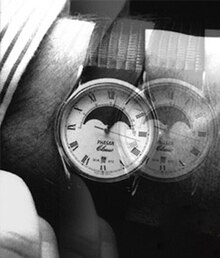
Back ازدواج الرؤية Arabic Diplopiya Azerbaijani Диплопия Bulgarian Diplopia Catalan Diplopie Czech Dobbeltsyn Danish Diplopie German Διπλωπία Greek Diplopía Spanish دوبینی Persian
| Diplopia | |
|---|---|
| Other names | Double vision |
 | |
| One way a person might experience double vision | |
| Specialty | Neurology, ophthalmology |
Diplopia is the simultaneous perception of two images of a single object that may be displaced horizontally or vertically in relation to each other.[1] Also called double vision, it is a loss of visual focus under regular conditions, and is often voluntary. However, when occurring involuntarily, it results from impaired function of the extraocular muscles, where both eyes are still functional, but they cannot turn to target the desired object.[2] Problems with these muscles may be due to mechanical problems, disorders of the neuromuscular junction, disorders of the cranial nerves (III, IV, and VI) that innervate the muscles, and occasionally disorders involving the supranuclear oculomotor pathways or ingestion of toxins.[3]
Diplopia can be one of the first signs of a systemic disease, particularly to a muscular or neurological process,[4] and it may disrupt a person's balance, movement, or reading abilities.[2][5]
- ^ Najem K, Margolin E (2021-07-18). "Diplopia". National Center for Biotechnology Information. PMID 28722934. Retrieved 2021-08-22 – via StatPearls.
- ^ a b O'Sullivan SB, Schmitz TJ (2007). Physical Rehabilitation. Philadelphia, PA: Davis. ISBN 978-0-8036-1247-1.
- ^ Blumenfeld H (2010). Neuroanatomy through Clinical Cases. Sunderland MA: Sinauer. ISBN 978-0-87893-058-6.
- ^ Rucker JC (July 2007). "Oculomotor disorders". Seminars in Neurology. 27 (3): 244–256. doi:10.1055/s-2007-979682. PMID 17577866. S2CID 260321300.
- ^ Kernich CA (July 2006). "Patient and family fact sheet. Diplopia". The Neurologist. 12 (4): 229–230. doi:10.1097/01.nrl.0000231927.93645.34. PMID 16832242.